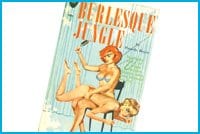Kate Zieman says she’s embarrassed to admit she wrote her masters thesis on queer theory using US sources. She wasn’t aware of the Canadian Lesbian and Gay Archives (CLGA) until she saw it listed in Xtra’s Pride Guide after the fact. In 2004 she became an information technology studies student at the University of Toronto and finally had her excuse to venture inside.
Zieman remembers being overwhelmed by the sheer volume of materials available. Her first volunteer assignment was to “create natural groupings” among the carefully stored but haphazardly arranged rare books. For Zieman the treasures tucked in among the other books were the lesbian pulp fiction titles.
Zieman had just finished reading an anthology of lesbian pulp fiction and was excited to actually hold the now-rare originals in her hands. While she enjoyed the reprinted editions the originals acted as a portal ? the fact that the books are “well-loved and a bit shabby” illustrated to Zieman how “thrilling, and anxiety-provoking” it must have been to surreptitiously devour these tales in the 1930s. Plus, adds Zieman, “That old book smell… I’m a sucker for it.”
Once immensely popular ? Vin Packer’s Spring Fire sold approximately 1.5 million copies in its first year of publication ? few original examples of this Sapphic subgenre remain. Zieman speculates that because the books were “so cheap, so mass-produced, they could be bought for 25 cents and hidden on top of the refrigerator” few readers considered them worth saving.
Being considered trash worked both for and against the survival of the serials: most copies were tossed yet the very idea that “no one was paying attention” allowed the authors to “sneak in subversive ideas.” By tracing the trajectory of the genre’s stock narratives from mandated punishment (usually violent death or renouncing one’s desires and repressing oneself into heterosexuality) to a grudging admission that lesbians “didn’t necessarily hate themselves,” one can experience the dawning of dykedom’s literary liberation.
Zieman hopes she will be able to work on an exhibit of lesbian pulp novels once the CLGA takes over its new location at 34 Isabella St which will have community and gallery spaces. She says she wants to share the excitement she felt when she first uncovered the artifacts.
CLGA is aiming to make queer women aware of its holdings and to solicit more acquisitions documenting lesbian history. Zieman makes a special plea: for anyone with lesbian pulp fiction hidden away in a drawer to consider donating it to CLGA so future generations can access the past. Though social conditions have advanced greatly since the 1930s Zieman says “it’s valuable to know what we’ve left behind.”
Kate Zieman’s current CLGA project is an online exhibit on the effects of literature on queer identity. She is seeking submissions (250 words and a scanned image) relating to the “book or periodical that first spurred the realization of queerness.”

 Why you can trust Xtra
Why you can trust Xtra


